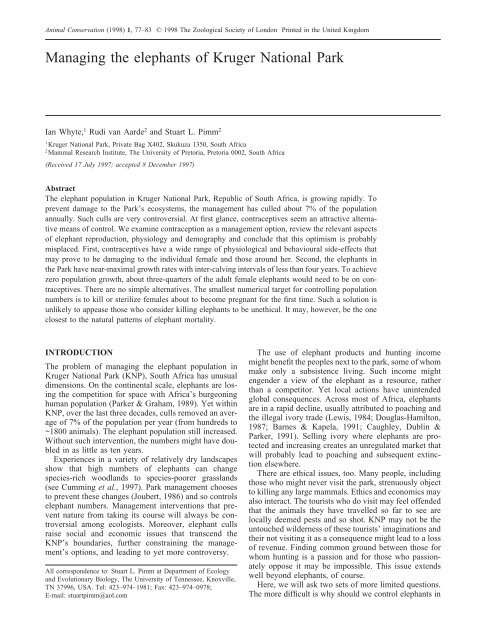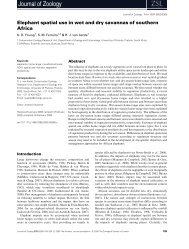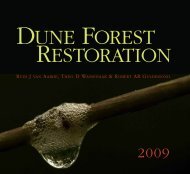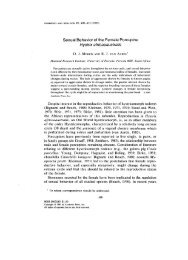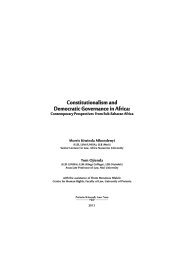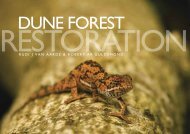Managing the elephants of Kruger National Park - CERU - University ...
Managing the elephants of Kruger National Park - CERU - University ...
Managing the elephants of Kruger National Park - CERU - University ...
Create successful ePaper yourself
Turn your PDF publications into a flip-book with our unique Google optimized e-Paper software.
Animal Conservation (1998) 1, 77–83 © 1998 The Zoological Society <strong>of</strong> London Printed in <strong>the</strong> United Kingdom<br />
<strong>Managing</strong> <strong>the</strong> <strong>elephants</strong> <strong>of</strong> <strong>Kruger</strong> <strong>National</strong> <strong>Park</strong><br />
Ian Whyte, 1 Rudi van Aarde 2 and Stuart L. Pimm 2<br />
1<br />
<strong>Kruger</strong> <strong>National</strong> <strong>Park</strong>, Private Bag X402, Skukuza 1350, South Africa<br />
2<br />
Mammal Research Institute, The <strong>University</strong> <strong>of</strong> Pretoria, Pretoria 0002, South Africa<br />
(Received 17 July 1997; accepted 8 December 1997)<br />
Abstract<br />
The elephant population in <strong>Kruger</strong> <strong>National</strong> <strong>Park</strong>, Republic <strong>of</strong> South Africa, is growing rapidly. To<br />
prevent damage to <strong>the</strong> <strong>Park</strong>’s ecosystems, <strong>the</strong> management has culled about 7% <strong>of</strong> <strong>the</strong> population<br />
annually. Such culls are very controversial. At first glance, contraceptives seem an attractive alternative<br />
means <strong>of</strong> control. We examine contraception as a management option, review <strong>the</strong> relevant aspects<br />
<strong>of</strong> elephant reproduction, physiology and demography and conclude that this optimism is probably<br />
misplaced. First, contraceptives have a wide range <strong>of</strong> physiological and behavioural side-effects that<br />
may prove to be damaging to <strong>the</strong> individual female and those around her. Second, <strong>the</strong> <strong>elephants</strong> in<br />
<strong>the</strong> <strong>Park</strong> have near-maximal growth rates with inter-calving intervals <strong>of</strong> less than four years. To achieve<br />
zero population growth, about three-quarters <strong>of</strong> <strong>the</strong> adult female <strong>elephants</strong> would need to be on contraceptives.<br />
There are no simple alternatives. The smallest numerical target for controlling population<br />
numbers is to kill or sterilize females about to become pregnant for <strong>the</strong> first time. Such a solution is<br />
unlikely to appease those who consider killing <strong>elephants</strong> to be unethical. It may, however, be <strong>the</strong> one<br />
closest to <strong>the</strong> natural patterns <strong>of</strong> elephant mortality.<br />
INTRODUCTION<br />
The problem <strong>of</strong> managing <strong>the</strong> elephant population in<br />
<strong>Kruger</strong> <strong>National</strong> <strong>Park</strong> (KNP), South Africa has unusual<br />
dimensions. On <strong>the</strong> continental scale, <strong>elephants</strong> are losing<br />
<strong>the</strong> competition for space with Africa’s burgeoning<br />
human population (<strong>Park</strong>er & Graham, 1989). Yet within<br />
KNP, over <strong>the</strong> last three decades, culls removed an average<br />
<strong>of</strong> 7% <strong>of</strong> <strong>the</strong> population per year (from hundreds to<br />
~1800 animals). The elephant population still increased.<br />
Without such intervention, <strong>the</strong> numbers might have doubled<br />
in as little as ten years.<br />
Experiences in a variety <strong>of</strong> relatively dry landscapes<br />
show that high numbers <strong>of</strong> <strong>elephants</strong> can change<br />
species-rich woodlands to species-poorer grasslands<br />
(see Cumming et al., 1997). <strong>Park</strong> management chooses<br />
to prevent <strong>the</strong>se changes (Joubert, 1986) and so controls<br />
elephant numbers. Management interventions that prevent<br />
nature from taking its course will always be controversial<br />
among ecologists. Moreover, elephant culls<br />
raise social and economic issues that transcend <strong>the</strong><br />
KNP’s boundaries, fur<strong>the</strong>r constraining <strong>the</strong> management’s<br />
options, and leading to yet more controversy.<br />
All correspondence to: Stuart L. Pimm at Department <strong>of</strong> Ecology<br />
and Evolutionary Biology, The <strong>University</strong> <strong>of</strong> Tennessee, Knoxville,<br />
TN 37996, USA. Tel: 423–974–1981; Fax: 423–974–0978;<br />
E-mail: stuartpimm@aol.com<br />
The use <strong>of</strong> elephant products and hunting income<br />
might benefit <strong>the</strong> peoples next to <strong>the</strong> park, some <strong>of</strong> whom<br />
make only a subsistence living. Such income might<br />
engender a view <strong>of</strong> <strong>the</strong> elephant as a resource, ra<strong>the</strong>r<br />
than a competitor. Yet local actions have unintended<br />
global consequences. Across most <strong>of</strong> Africa, <strong>elephants</strong><br />
are in a rapid decline, usually attributed to poaching and<br />
<strong>the</strong> illegal ivory trade (Lewis, 1984; Douglas-Hamilton,<br />
1987; Barnes & Kapela, 1991; Caughley, Dublin &<br />
<strong>Park</strong>er, 1991). Selling ivory where <strong>elephants</strong> are protected<br />
and increasing creates an unregulated market that<br />
will probably lead to poaching and subsequent extinction<br />
elsewhere.<br />
There are ethical issues, too. Many people, including<br />
those who might never visit <strong>the</strong> park, strenuously object<br />
to killing any large mammals. Ethics and economics may<br />
also interact. The tourists who do visit may feel <strong>of</strong>fended<br />
that <strong>the</strong> animals <strong>the</strong>y have travelled so far to see are<br />
locally deemed pests and so shot. KNP may not be <strong>the</strong><br />
untouched wilderness <strong>of</strong> <strong>the</strong>se tourists’ imaginations and<br />
<strong>the</strong>ir not visiting it as a consequence might lead to a loss<br />
<strong>of</strong> revenue. Finding common ground between those for<br />
whom hunting is a passion and for those who passionately<br />
oppose it may be impossible. This issue extends<br />
well beyond <strong>elephants</strong>, <strong>of</strong> course.<br />
Here, we will ask two sets <strong>of</strong> more limited questions.<br />
The more difficult is why should we control <strong>elephants</strong> in
78 I. WHYTE ET AL.<br />
<strong>the</strong> first place? The second is how do we go about doing<br />
it?<br />
‘Playing God’ is <strong>the</strong> frequent criticism – including by<br />
an anonymous reviewer <strong>of</strong> this paper – <strong>of</strong> those wildlife<br />
managers who would intervene in <strong>the</strong> natural course <strong>of</strong><br />
things. The elephant problem in KNP is self-imposed:<br />
<strong>the</strong> decision to control <strong>elephants</strong> is based on speculation<br />
about what would happen if <strong>the</strong> <strong>elephants</strong> were to<br />
increase. Yet such speculation may be unavoidable. The<br />
obvious experiment <strong>of</strong> letting <strong>the</strong> <strong>elephants</strong> increase<br />
could have unfortunate consequences to <strong>the</strong> ecosystem<br />
and <strong>the</strong> species that depend on it that persist for decades<br />
or longer.<br />
These consequences raise more questions. Did <strong>elephants</strong><br />
effect such ecosystem changes in <strong>the</strong> past? Even<br />
if <strong>the</strong>y did, should <strong>the</strong>y do it now? What were <strong>the</strong> natural<br />
processes that regulated elephant numbers in <strong>the</strong><br />
past? And what is ‘natural’ today in an Africa with a<br />
large and rapidly growing human population and few<br />
well-protected parks?<br />
Given <strong>the</strong> choice <strong>of</strong> controlling elephant numbers,<br />
does KNP’s management have alternatives to killing <strong>elephants</strong><br />
that will still keep <strong>the</strong>ir numbers low? The use<br />
<strong>of</strong> contraceptives has been touted as a promising solution<br />
(Short, 1992; The Economist, 1996). Consequently,<br />
much effort has been spent to investigate <strong>the</strong> endocrinology<br />
<strong>of</strong> <strong>elephants</strong> and to evaluate <strong>the</strong> potential use <strong>of</strong> substances<br />
such as RU3486 that may block implantation<br />
(Greyling, van Aarde & Potgieter, 1997; Greyling, Ford<br />
et al., in press). O<strong>the</strong>r methods based on ei<strong>the</strong>r immunocontraception<br />
or slow-releasing estrogen implants are<br />
presently under trial in KNP.<br />
We outline <strong>the</strong> serious and unpredictable consequences<br />
to <strong>the</strong> individuals <strong>of</strong> <strong>the</strong>se methods. These<br />
include changes in behaviour, social status within <strong>the</strong><br />
breeding herd, and in <strong>the</strong> steroidogenic activities <strong>of</strong> <strong>the</strong><br />
ovary and uterus. Females treated with estrogen implants<br />
may remain in permanent estrus. We cannot predict<br />
ei<strong>the</strong>r <strong>the</strong>ir behaviour or <strong>the</strong> consequences that this<br />
may have for <strong>the</strong> park’s male <strong>elephants</strong>. Moreover,<br />
contraception is impractical. We will present models <strong>of</strong><br />
elephant demographics to show that perhaps 75% <strong>of</strong><br />
female <strong>elephants</strong> would need to be treated. Even at this<br />
level, <strong>the</strong> number to be treated would grow for well over<br />
a decade before we would achieve zero population<br />
growth.<br />
Finally, we ask what is <strong>the</strong> smallest number <strong>of</strong> animals<br />
one should kill or sterilize if <strong>the</strong> goal is to control<br />
<strong>the</strong> population. In this answer is more than just a practical<br />
solution to controlling <strong>the</strong> population. For it identifies<br />
<strong>the</strong> weak link in <strong>the</strong> chain <strong>of</strong> life-history – <strong>the</strong> age<br />
and sex group where natural processes would make <strong>the</strong><br />
largest difference to whe<strong>the</strong>r <strong>the</strong> elephant population<br />
increased or decreased.<br />
WHY CONTROL ELEPHANT NUMBERS?<br />
In at least some dry forests, increasing numbers <strong>of</strong><br />
<strong>elephants</strong> progressively destroy <strong>the</strong> forest and convert<br />
it into more open habitats (Laws, 1970; Barnes, 1980,<br />
1983; Douglas-Hamilton, 1987; Dublin, Sinclair &<br />
McClade, 1990; Jachman & Croes, 1991; Dublin, 1994;<br />
Leuthold, 1996; see Lawton & Gough (1970), Guy<br />
(1982) and Ben-Shahar (1996) for alternative explanations).<br />
In KNP, <strong>elephants</strong> also suppress <strong>the</strong> rejuvenation<br />
<strong>of</strong> selected woodland trees (Viljoen, 1988; Trollope et<br />
al., in press). By comparing ecosystems on ei<strong>the</strong>r side <strong>of</strong><br />
an elephant fence, Cumming et al. (1997) demonstrated<br />
significant reductions in <strong>the</strong> species richness <strong>of</strong> birds, ants<br />
and o<strong>the</strong>r taxa, where <strong>elephants</strong> have removed <strong>the</strong> tree<br />
canopy.<br />
There are several reasons why we may wish to prevent<br />
<strong>the</strong>se changes. We might justify <strong>the</strong> low elephant<br />
numbers from assessments <strong>of</strong> biodiversity. Naturally<br />
high elephant numbers may have made woodlands and<br />
<strong>the</strong>ir inhabitants scarce or local. On a continent where<br />
so little protected habitat remains, <strong>the</strong>re may be <strong>the</strong> need<br />
to conserve a set <strong>of</strong> species more localized and so more<br />
vulnerable to extinction than <strong>elephants</strong> (Hoeft & Hoeft,<br />
1995). This justification explicitly recognizes that restoring<br />
nature to its original state on its original scale may<br />
now be impossible.<br />
Alternatively, <strong>the</strong> target size that <strong>the</strong> population must<br />
not exceed may be historically justified. Phrased ano<strong>the</strong>r<br />
way, conditions may be different now and we need to<br />
restore <strong>the</strong>m to <strong>the</strong>ir former, natural state. We are reasonably<br />
sure that elephant densities are now different<br />
from <strong>the</strong> recent past. Evidence suggests that KNP held<br />
only low numbers <strong>of</strong> <strong>elephants</strong> at <strong>the</strong> turn <strong>of</strong> <strong>the</strong> century<br />
(Vaughn Kirby, 1896; Whyte, in prep.). Pienaar, van<br />
Wyk & Fairall (1966) estimated <strong>the</strong> 1947 population to<br />
be 560 <strong>elephants</strong>. During <strong>the</strong> 1960 (first) aerial survey<br />
<strong>the</strong> population comprised 1186 individuals (Pienaar et<br />
al., 1966). Whe<strong>the</strong>r <strong>the</strong>se were natural low numbers or,<br />
as Spinage (1973) has argued, <strong>the</strong> consequences <strong>of</strong> <strong>the</strong><br />
ivory trade is still debatable.<br />
If <strong>the</strong> latter explanation holds, <strong>the</strong>n <strong>elephants</strong> would<br />
naturally have been abundant. So why were <strong>the</strong>re originally<br />
any areas with extensive woodlands? Elephants<br />
might increase over century long time scales, destroying<br />
<strong>the</strong> woodlands in <strong>the</strong> process, and thus causing <strong>the</strong>ir<br />
own decline (Caughley, 1976). Elephants and forests<br />
might co-exist only over very large spatial scales that<br />
permit large mosaics <strong>of</strong> soon-to-be-destroyed woodland,<br />
about-to-recover near-treeless ecosystems and everything<br />
in between. Finely resolved palynological data<br />
might elucidate such changes, but we are not aware <strong>of</strong><br />
such studies over sufficiently large areas.<br />
In any case, even parks as large as KNP’s 20 000 km 2<br />
may be too small to allow such cycles to operate. The<br />
idea <strong>of</strong> trans-frontier conservation areas (‘peace parks’)<br />
– huge protected areas that stretch across international<br />
barriers – may take care <strong>of</strong> some <strong>of</strong> <strong>the</strong>se problems <strong>of</strong><br />
geographic scale. The realization <strong>of</strong> such parks is still<br />
in <strong>the</strong> future.<br />
If <strong>the</strong> explanation that <strong>elephants</strong> were always at low<br />
numbers is correct, <strong>the</strong>n what were <strong>the</strong> reasons why <strong>elephants</strong><br />
remained scarce and what has changed? To<br />
answer <strong>the</strong>se questions we need to consider elephant<br />
demography.
Elephant management in <strong>Kruger</strong> <strong>National</strong> <strong>Park</strong><br />
79<br />
ELEPHANT DEMOGRAPHY<br />
One does not need a detailed demographic model to<br />
expect that <strong>elephants</strong>, like humans, can increase rapidly<br />
in numbers. The parameters are broadly similar. Laws<br />
& <strong>Park</strong>er (1968), Laws, <strong>Park</strong>er & Johnstone (1975),<br />
Hachman (1980), Dunham (1988) and references <strong>the</strong>rein<br />
summarize <strong>the</strong>m. Like humans, female <strong>elephants</strong> have a<br />
life span <strong>of</strong> ~60 years, with between 2·5 and 5% <strong>of</strong> <strong>the</strong><br />
population dying each year. They have a mean age <strong>of</strong><br />
first calving from 11 to 20 years old. Gestation is 22<br />
months, and <strong>the</strong> inter-calving interval can be as short as<br />
three years or as infrequent as nine years. Unlike<br />
humans, <strong>the</strong>y remain fertile until into <strong>the</strong>ir late fifties.<br />
In KNP, some females have given birth in <strong>the</strong>ir 12th<br />
year and most have given birth by <strong>the</strong> time <strong>the</strong>y are 13<br />
years old (Smuts, 1975). A culled sample <strong>of</strong> 966 adult<br />
cows shows an almost exact equality in <strong>the</strong> numbers <strong>of</strong><br />
those pregnant (484) and non-pregnant (482). This<br />
means that, on average, a cow is pregnant for half <strong>of</strong> her<br />
adult life. Thus <strong>the</strong> calving interval will be twice <strong>the</strong> gestation<br />
time <strong>of</strong> 22 months, i.e. 44 months or 3·67 years<br />
(Whyte, in prep.)<br />
There is no long-term, cohort-based study <strong>of</strong> survivorship.<br />
One way to estimate <strong>the</strong> annual mortality is<br />
from <strong>the</strong> size <strong>of</strong> <strong>the</strong> cull itself and how fast <strong>the</strong> numbers<br />
grow despite it. Two factors increase <strong>the</strong> population:<br />
births and immigration from areas outside <strong>the</strong> park.<br />
Immigration from Mozambique was a probable cause <strong>of</strong><br />
<strong>the</strong> increase <strong>of</strong> ~6600 in 1967 to 8800 in 1970. It is less<br />
likely to explain <strong>the</strong> changes in <strong>the</strong> last two decades<br />
(Walker et al., 1987). There are few <strong>elephants</strong> in <strong>the</strong><br />
conservation and agricultural areas to <strong>the</strong> west <strong>of</strong> <strong>the</strong><br />
KNP. KNP fenced <strong>the</strong> long eastern and shorter nor<strong>the</strong>rn<br />
and sou<strong>the</strong>rn boundaries in 1970. We suggest that immigration<br />
made, at best, only a small contribution to <strong>the</strong><br />
population’s growth rate after 1972. Whatever <strong>the</strong> contribution<br />
<strong>of</strong> immigration, practically, we must include it<br />
in our calculations as if it were a birth rate, for <strong>the</strong>re is<br />
no way we can exclude more animals.<br />
From 1973 to 1994 inclusive, <strong>the</strong> cull averaged 6·7%<br />
<strong>of</strong> KNP’s <strong>elephants</strong>. The population ended this period at<br />
much <strong>the</strong> same size (7800) as it started (7600) and fluctuated<br />
between a low <strong>of</strong> 6900 and a high <strong>of</strong> 8700 animals.<br />
From year to year, <strong>the</strong> population always increased<br />
when <strong>the</strong> cull was less than 5%. It increased one year<br />
to <strong>the</strong> following year in nine different years when <strong>the</strong><br />
cull was 0, 4, 4, 4, 4, 5, 5, 5 and 6% <strong>of</strong> <strong>the</strong> animals,<br />
respectively. Given <strong>the</strong> inevitable uncertainties in counting<br />
animals, increases may reflect under-counting in one<br />
year followed by over-counting in <strong>the</strong> following year.<br />
We discount <strong>the</strong> single high value <strong>of</strong> 6% because <strong>of</strong> this<br />
possibility. The consistent increases in population when<br />
between 4 and 5% <strong>of</strong> <strong>the</strong> animals are killed makes 5%<br />
a reasonable estimate <strong>of</strong> <strong>the</strong> population’s growth rate. A<br />
population growing at 5% annually, all females calving<br />
first in <strong>the</strong>ir 12th year and at 3·67 years <strong>the</strong>reafter, allows<br />
a back calculation <strong>of</strong> annual mortality <strong>of</strong> 1·5%.<br />
If <strong>the</strong>se rapidly growing elephant populations are not<br />
typical <strong>of</strong> KNP’s original state, <strong>the</strong>n what has changed?<br />
For this question a simple demographic model provides<br />
interesting answers. The model assumes constant survivorship<br />
up to 60 years (and no survivors beyond that<br />
age), and specifies <strong>the</strong> age <strong>of</strong> first calving and calving<br />
interval. In nature, <strong>the</strong>se parameters are not independent:<br />
poor food conditions and high elephant densities will<br />
probably affect all three. In particular, Dobson (1993)<br />
summarizes data showing how <strong>the</strong> age at first calving<br />
declines with increasing elephant densities. The effect<br />
<strong>of</strong> density on inter-birth interval is less obvious. We<br />
assume no marked changes in numbers – for that is <strong>the</strong><br />
management objective – and so, for simplicity, we fix<br />
each parameter at a given value.<br />
The fetal sex ratio for <strong>elephants</strong> in KNP is 1:1 (Smuts,<br />
1975; Whyte, in prep.). This ratio persists until 14 years<br />
old, when <strong>the</strong> young males leave <strong>the</strong> breeding herds and<br />
join bachelor groups. The mortality <strong>of</strong> bulls in bachelor<br />
groups is unknown. It is likely to be slightly higher than<br />
in adult cows, but still low, as KNP has recorded few<br />
natural deaths <strong>of</strong> adult bulls. In our model, we need<br />
assume only that <strong>the</strong>re are sufficient males in <strong>the</strong> population<br />
to permit <strong>the</strong> females to produce young whenever<br />
<strong>the</strong>y are able to do so.<br />
We explored <strong>the</strong> growth rates under <strong>the</strong> combinations<br />
<strong>of</strong> maximum and minimum values <strong>of</strong> <strong>the</strong> three reproductive<br />
parameters we have discussed so far. Our objective<br />
was to find <strong>the</strong> parameter changes which were most<br />
likely to effect changes in KNP’s elephant numbers.<br />
With our model, <strong>elephants</strong> can increase when mortality<br />
is as high as 5% per year and when <strong>the</strong> age at first<br />
calving is as late as 20 years. In contrast, when <strong>the</strong> intercalving<br />
interval is as long as nine years, <strong>the</strong> population<br />
can only grow slowly under <strong>the</strong> best circumstances <strong>of</strong><br />
low mortality and young age <strong>of</strong> first breeding. Given <strong>the</strong><br />
natural range <strong>of</strong> parameters, <strong>the</strong> inter-calving interval<br />
should play <strong>the</strong> major role in driving <strong>the</strong> population<br />
changes – a conclusion <strong>of</strong> Dobson (1993) and Hanks &<br />
McIntosh (1973).<br />
If KNP is now different for <strong>elephants</strong> than in <strong>the</strong> past,<br />
<strong>the</strong>n changes in calving interval are <strong>the</strong> prime suspect.<br />
Notice, first, that long calving intervals are demographically<br />
equivalent to short calving intervals combined<br />
with high pre-breeding mortality. The interval between<br />
a female producing a youngster <strong>of</strong> breeding age is long<br />
in both circumstances. Juvenile (i.e. pre-breeding) mortality<br />
might have been consistently higher in <strong>the</strong> past.<br />
Hunting by Stone- or Iron-age cultures might have<br />
elevated juvenile mortality. So, too, might <strong>the</strong> long distances<br />
between water sources – for young <strong>elephants</strong> are<br />
prone to die during droughts (Dunham, 1988). KNP’s<br />
extensive network <strong>of</strong> engineered water holes may have<br />
tweaked <strong>the</strong> parameter – pre-breeding mortality – that<br />
can effect <strong>the</strong> greatest change in <strong>the</strong> growth rate <strong>of</strong> a<br />
population. The drought in <strong>the</strong> early 1980s had little<br />
effect on <strong>the</strong> growth rate <strong>of</strong> KNP’s <strong>elephants</strong>, though,<br />
interestingly, <strong>the</strong>y did unusual amounts <strong>of</strong> damage to<br />
trees in that period (Walker et al., 1987).<br />
The demographic model suggests that juvenile mortality<br />
caused by droughts could be episodic and still slow<br />
growth rates to near zero. One episode in every 11 years
80 I. WHYTE ET AL.<br />
would be enough to severely impact all <strong>the</strong> pre-breeding<br />
age classes.<br />
The parameters for KNP’s <strong>elephants</strong> <strong>of</strong> age at first<br />
calving, inter-calving interval, and annual survival are<br />
close to or exceed <strong>the</strong> maximum observed elsewhere.<br />
Calef (1988) suggests 8% as <strong>the</strong> <strong>the</strong>oretical maximum<br />
growth rate for <strong>elephants</strong>. We agree with Dobson (pers.<br />
comm.) that this seems to be far too high. We employ<br />
age-structured models similar to those <strong>of</strong> Dobson (1993).<br />
The models suggest that KNP’s particular problem is to<br />
regulate <strong>elephants</strong> at a density at which resource limitation<br />
is minimal. The management problem is thus maximally<br />
difficult. Do contraceptives provide a practical<br />
solution?<br />
CONSEQUENCES OF CONTRACEPTION FOR<br />
THE INDIVIDUAL<br />
Contraceptive use aims to control <strong>the</strong> elephant population<br />
without <strong>the</strong> killing <strong>of</strong> animals that so many find<br />
objectionable. It also holds <strong>the</strong> promise <strong>of</strong> being<br />
reversible. Were some natural event to greatly reduce<br />
<strong>the</strong> population, <strong>the</strong> contraceptive programme could be<br />
stopped and <strong>the</strong> population could recover quickly. In<br />
spite <strong>of</strong> limited information, we may predict some <strong>of</strong><br />
<strong>the</strong> physiological and behavioural consequences <strong>of</strong> <strong>the</strong><br />
substances presently on trial as contraceptives. These<br />
consequences will probably thwart <strong>the</strong> promise <strong>of</strong> contraception<br />
as both humane and reversible.<br />
Studies on endocrine correlates <strong>of</strong> elephant reproduction<br />
show that blood levels <strong>of</strong> both estrogens and progestins<br />
are extremely low in <strong>the</strong> African elephant (Plotka<br />
et al., 1975; De Villiers, Skinner & Hall-Martin, 1989).<br />
In contrast to most o<strong>the</strong>r mammals, relatively high concentrations<br />
<strong>of</strong> <strong>the</strong> 5-reduced metabolites <strong>of</strong> progesterone<br />
ra<strong>the</strong>r than progesterone appear to maintain pregnancy<br />
in <strong>the</strong> elephant (Hodges, van Aarde et al., 1994; Hodges,<br />
Heistermann et al., 1997; Greyling, van Aarde et al.,<br />
1997). As yet, we cannot discount <strong>the</strong> role <strong>of</strong> progesterone<br />
in <strong>the</strong> maintenance <strong>of</strong> pregnancy. Elephants may<br />
be extremely sensitive to this steroid, resulting in<br />
extremely low concentrations being sufficient to support<br />
pregnancy. This may also be true for <strong>the</strong> interactions<br />
between estrogens and ovarian function. Such a possibility<br />
requires fur<strong>the</strong>r investigation, preferably on captive<br />
animals.<br />
Circulating concentrations <strong>of</strong> oestradiol-17 are<br />
extremely low (Plotka et al., 1975; McNeilly et al.,<br />
1983) and endometrial receptor affinity is highly specific<br />
(Greyling, van Aarde et al., 1997; Greyling, Ford et al.,<br />
in press). Estrogens in <strong>the</strong> elephant, as in o<strong>the</strong>r mammals,<br />
probably originate from developing ovarian follicles.<br />
Ovulation and incidences <strong>of</strong> estrus may be<br />
associated with a surge in <strong>the</strong>ir plasma concentrations<br />
but circulating levels are extremely low (see Hess,<br />
Schmidt & Schmidt, 1983).<br />
The slow-releasing capsules recently implanted in ten<br />
lactating <strong>elephants</strong> in KNP resulted in continued high<br />
concentrations <strong>of</strong> oestradiol-17. The consequences may<br />
be an impairment <strong>of</strong> lactation and a consequent reduction<br />
in calf survival. Moreover, <strong>the</strong> treated cows remained<br />
in a continuous state <strong>of</strong> sexual heat. They appear to have<br />
been evicted from <strong>the</strong>ir breeding groups and were <strong>of</strong>ten<br />
harassed by bulls (Whyte & Grobler, 1997).<br />
Considering <strong>the</strong> influence <strong>of</strong> sexually associated<br />
aggression in bulls on calves, <strong>the</strong> high incidence <strong>of</strong> cows<br />
in heat, may also have major consequences for <strong>the</strong> unexpected<br />
tourist. One should consider that at any given time<br />
at least some 2000 cows will be experiencing this condition<br />
(see below). In addition, we cannot discount <strong>the</strong><br />
potential for continued high levels <strong>of</strong> estrogens to induce<br />
<strong>the</strong> carcinomic growths that have developed in o<strong>the</strong>r<br />
species (Li, Li et al., 1983; Li, Oberley et al., 1988).<br />
Information from <strong>the</strong> group <strong>of</strong> scientists recently<br />
involved in immunizing 21 elephant cows with porcine<br />
zona pellucida antibody (pZP) suggests that animals will<br />
have to be given a booster at yearly intervals to ensure<br />
effectiveness <strong>of</strong> this antibody as a contraceptive (H. J.<br />
Bertschinger, pers. comm.). Apparently, immunocontraception<br />
is effective in several free-ranging mammal<br />
species. The method’s protagonists (see Bertschinger et<br />
al., 1996) claim minimal effects and even reversibility<br />
(Kirkpatrick, Liu et al., 1992; Turner, Liu & Kirkpatrick,<br />
1992; Kirkpatrick, Turner & Liu, 1996). O<strong>the</strong>rs claim<br />
evidence to <strong>the</strong> contrary (see Mahi-Brown et al. 1989;<br />
Paterson, Koothan et al., 1992; Paterson, Wilson et al.,<br />
1996). Active immunization with <strong>the</strong> zona glycoprotein<br />
induces infertility. It also causes ovarian dysfunction and<br />
ovarian pathology characterized by a lack <strong>of</strong> folliculogenesis<br />
and depletion <strong>of</strong> <strong>the</strong> primordial follicle population<br />
(Paterson, Wilson et al., 1996). If this proves to be<br />
<strong>the</strong> case for <strong>elephants</strong>, such sterilized individuals would<br />
be removed permanently from <strong>the</strong> gene pool – an effect<br />
similar to that achieved through culling.<br />
In summary, all <strong>of</strong> <strong>the</strong> methods currently under test<br />
have known or predicted serious consequences to <strong>the</strong><br />
health <strong>of</strong> <strong>the</strong> cows, <strong>the</strong>ir behaviour, and those animals<br />
around <strong>the</strong>m. This is not <strong>the</strong> only problem with<br />
contraceptives.<br />
CONTRACEPTIVE OPTIONS FOR THE<br />
ELEPHANTS OF KRUGER NATIONAL PARK<br />
Contraceptives alter <strong>the</strong> inter-calving interval and so<br />
<strong>of</strong>fer a potentially effective way <strong>of</strong> controlling population<br />
numbers. Using <strong>the</strong> demographic model introduced<br />
above, we can perform a straightforward calculation <strong>of</strong><br />
how many <strong>of</strong> KNP’s roughly 3000 reproductively active<br />
female <strong>elephants</strong> would need to be administered contraceptives<br />
to ensure zero population growth. The bad news<br />
is that <strong>the</strong> answer is about 75% – reducing <strong>the</strong> average<br />
calving interval to about 12 years.<br />
The worse news is that zero population growth rate<br />
only kicks in after 11 years. In that 11-year interval,<br />
females born before <strong>the</strong> use <strong>of</strong> <strong>the</strong> contraceptives are<br />
steadily recruited into <strong>the</strong> breeding population. Indeed,<br />
11-year-olds are <strong>the</strong> largest breeding class, since <strong>the</strong>re<br />
cannot be more 12-year-olds than 11-year-olds, 13-yearolds<br />
than 12-year-olds, and so on. Consequently, <strong>the</strong><br />
breeding population increases at about 4% per year to
Elephant management in <strong>Kruger</strong> <strong>National</strong> <strong>Park</strong><br />
81<br />
over 5000 adult females before zero population growth<br />
is attained. Thus, <strong>the</strong> final effort requires ~4000 animals<br />
to have contraceptives – not <strong>the</strong> initial number <strong>of</strong> 2250<br />
(= 75% <strong>of</strong> 3000).<br />
The parameter for which we have <strong>the</strong> least confidence<br />
is <strong>the</strong> annual survival. It is a back calculation that<br />
assumes a particular growth model and fur<strong>the</strong>r assumes<br />
how <strong>the</strong> population would have grown without <strong>the</strong> cull.<br />
If we increase <strong>the</strong> annual mortality from <strong>the</strong> 1·5%<br />
employed in <strong>the</strong> previous paragraph to 2·5%, <strong>the</strong>n <strong>the</strong><br />
required fraction <strong>of</strong> females treated with contraceptives<br />
declines only from 75% to 61%. Simply, it is <strong>the</strong> very<br />
short inter-calving interval <strong>of</strong> KNP’s <strong>elephants</strong> that<br />
makes <strong>the</strong> problem a difficult one.<br />
Our model also confirms Dobson’s result that using<br />
contraceptives to delay <strong>the</strong> age at first calving is an even<br />
less effective strategy than changing <strong>the</strong> inter-calving<br />
interval.<br />
OTHER MANAGEMENT OPTIONS<br />
The model permits a numerically simple solution to <strong>the</strong><br />
park’s problems. Ra<strong>the</strong>r than kill from hundreds to thousands<br />
<strong>of</strong> <strong>elephants</strong> each year, or put contraceptives in<br />
several thousand females, <strong>the</strong> killing <strong>of</strong> a much smaller<br />
number <strong>of</strong> female <strong>elephants</strong> just prior <strong>the</strong>ir first pregnancy<br />
would achieve <strong>the</strong> same aim. Killing a mere 300<br />
<strong>of</strong> such carefully selected animals each year would drive<br />
<strong>the</strong> population to extinction, for no breeding females<br />
would enter <strong>the</strong> population. Killing 250 would stabilize<br />
<strong>the</strong> population.<br />
The word ‘sterilize’ can be substituted for ‘kill’ in <strong>the</strong><br />
previous paragraph and its conclusions be unchanged.<br />
Contraception and sterilization are not usually considered<br />
to be synonyms. Indeed, <strong>the</strong> efforts discussed above<br />
aim to find reversible contraceptives and to avoid sterilization<br />
as <strong>the</strong> unintended consequence <strong>of</strong> our ignorance<br />
<strong>of</strong> how <strong>the</strong> contraceptives function. If sterilization, and<br />
not contraception, is <strong>the</strong> intended objective, <strong>the</strong>n it<br />
should be stated as such. The ethical issues this raises<br />
should be brought into <strong>the</strong> open and <strong>the</strong> research programme<br />
focused on deliberate sterilization.<br />
CONCLUSIONS<br />
KNP has four management options. It has chosen <strong>the</strong><br />
option <strong>of</strong> killing from hundreds to thousands <strong>of</strong> <strong>elephants</strong><br />
each year for decades to protect its woodland<br />
ecosystems. The o<strong>the</strong>r three options are to let <strong>elephants</strong><br />
increase and lose its woodland, kill or sterilize 250 prebreeding<br />
females, or administer contraceptives to 75%<br />
<strong>of</strong> all <strong>the</strong> breeding females.<br />
There is nothing sacrosanct about keeping <strong>the</strong> elephant<br />
population at its current level, <strong>of</strong> course. One<br />
might choose any mix <strong>of</strong> <strong>the</strong> four options, including<br />
higher elephant numbers, likely higher inter-calving<br />
intervals and so a proportionately smaller number <strong>of</strong><br />
animals killed, contracepted or sterilized, and more damage<br />
to <strong>the</strong> woodlands. The optimal balance between elephant<br />
numbers and woodland is not easy to determine<br />
without long-term, large-scale experiments. Moreover,<br />
with larger numbers <strong>of</strong> <strong>elephants</strong>, <strong>the</strong> absolute numbers<br />
to be killed, contracepted or sterilized will also be<br />
larger.<br />
There is still a debate about whe<strong>the</strong>r or not woodland<br />
– and <strong>the</strong> low elephant numbers that permit its existence<br />
– was naturally <strong>the</strong> permanent or even an episodic state<br />
<strong>of</strong> this region. What is certainly not natural is <strong>the</strong> small<br />
fraction <strong>of</strong> protected land in Africa (and elsewhere), <strong>the</strong><br />
consequent rates <strong>of</strong> global extinction, and <strong>the</strong> loss <strong>of</strong><br />
ecological processes across <strong>the</strong> landscape. Protecting<br />
woodland may be essential to preserve for <strong>the</strong> future a<br />
representative sample <strong>of</strong> species and processes, whatever<br />
<strong>the</strong> past may have been.<br />
If <strong>the</strong>re were few <strong>elephants</strong> in <strong>the</strong> past, <strong>the</strong>n <strong>the</strong> first<br />
question is why? The second is how do we keep elephant<br />
numbers low? The numerical targets required for zero<br />
growth range from selectively killing or sterilizing a<br />
few hundred 11-year-old females to indiscriminately<br />
killing many hundreds <strong>of</strong> animals, to using contraceptives<br />
on several thousand adult females. There will also<br />
be some individuals who find killing any <strong>elephants</strong> an<br />
ana<strong>the</strong>ma. Unfortunately, <strong>the</strong> use <strong>of</strong> contraceptives on<br />
this scale is completely impractical and <strong>the</strong>y are likely<br />
to have severe behavioural and physiological sideeffects.<br />
Should one unnaturally shoot or sterilize female<br />
<strong>elephants</strong> prior to calving for <strong>the</strong> first time or let <strong>the</strong>m<br />
die naturally <strong>of</strong> thirst in dry years? This is an ethical<br />
issue we are not equipped to judge. Nature is not likely<br />
to be so squeamish.<br />
Identifying <strong>the</strong> smallest numerical target for controlling<br />
elephant numbers is not just a practical convenience.<br />
It is <strong>the</strong> most likely target for how <strong>the</strong> vagaries <strong>of</strong> nature<br />
limit elephant numbers. The high mortality <strong>of</strong> juvenile<br />
<strong>elephants</strong> may explain why some populations have<br />
remained at numbers that do not lead to <strong>the</strong>ir destroying<br />
woodlands. In this sense, <strong>the</strong> smallest target for control<br />
is also likely to be <strong>the</strong> most natural one. Whatever<br />
<strong>the</strong> ethical issues <strong>of</strong> sterilizing female <strong>elephants</strong>, it does<br />
provide <strong>the</strong> smallest numerical target and it avoids<br />
killing animals.<br />
REFERENCES<br />
Barnes, R. F. W. (1980). The decline <strong>of</strong> <strong>the</strong> baobab tree in Ruaha<br />
<strong>National</strong> <strong>Park</strong>, Tanzania. Afr. J. Ecol. 18: 243–252.<br />
Barnes, R. F. W. (1983). Effects <strong>of</strong> elephant browsing on woodlands<br />
in a Tanzanian <strong>National</strong> <strong>Park</strong>: measurements, models and<br />
management. J. appl. Ecol. 20: 521–540.<br />
Barnes, R. F. W. & Kapela, E. B. (1991). Changes in <strong>the</strong> Ruaha<br />
elephant population caused by poaching. Afr. J. Ecol. 29:<br />
289–294.<br />
Ben-Shahar, R. (1996). Woodland dynamics under <strong>the</strong> influence<br />
<strong>of</strong> <strong>elephants</strong> and fire in nor<strong>the</strong>rn Botswana. Vegetagio 123:<br />
153–163.<br />
Bertschinger, H. J., Fayrer-Hosken, R., Kirkpatrick, J. R., Soley,<br />
J. T., Steffens, W. & Ard, M. (1996). Immunochemistry <strong>of</strong> <strong>the</strong><br />
elephant zona pellucida using anti-pZP antibodies. Int. Conf.<br />
Fert. control for Wildl. Mgmt. Great Keppel Island. Queensland,<br />
Australia.<br />
Calef, G. W. (1988). Maximum rate <strong>of</strong> increase in <strong>the</strong> African<br />
elephant. Afr. J. Ecol. 26: 323–327.
82 I. WHYTE ET AL.<br />
Caughley, G. (1976). The elephant problem – an alternative<br />
hypo<strong>the</strong>sis. E. Afr. Wildl. J. 14: 265–283.<br />
Caughley, G., Dublin, H., & <strong>Park</strong>er, I. (1990). Projected decline<br />
<strong>of</strong> <strong>the</strong> African elephant. Biol. Conserv. 54: 157–164.<br />
Cumming, D. H., Fenton, M.B., Rautenbach, I. L., Taylor, R. D.,<br />
Cumming, C. S., Dunlop, J. M., Ford, A. G., Hovorka, M. D.,<br />
Johnstohn, D. S., Kalcounis, M., Malangu, Z. & Portfors,<br />
C. V. R. (1997). Elephants, woodlands and biodiversity in sou<strong>the</strong>rn<br />
Africa. S. Afr. J. Sci. 93: 231–236.<br />
de Villiers, D. J., Skinner, J. D. & Hall-Martin, A. J. (1989).<br />
Circulating progesterone concentrations and ovarian functional<br />
anatomy in <strong>the</strong> African elephant (Loxodonta africana). J.<br />
Reprod. Fert. 86: 195–201.<br />
Dobson, A. P. (1993). Effect <strong>of</strong> fertility control on elephant population<br />
dynamics. J. Reprod. Fert. 90. Supplement 293–298.<br />
Douglas-Hamilton, I. (1987). African <strong>elephants</strong>: population trends<br />
and <strong>the</strong>ir causes. Oryx 12: 11–24.<br />
Dublin, H. T. (1994). Vegetation dynamics in <strong>the</strong> Serengeti-Mara<br />
ecosystem: <strong>the</strong> role <strong>of</strong> <strong>elephants</strong>, fire, and o<strong>the</strong>r factors. In<br />
Serengeti II: dynamics, management, and conservation <strong>of</strong> an<br />
ecosystem: 71–90. Sinclair, A. R. E. & Arcese, P. (Eds).<br />
Chicago: <strong>University</strong> <strong>of</strong> Chicago Press.<br />
Dublin, H. T., Sinclair, A. R. E. & McGlade, J. (1990). Elephants<br />
and fire as causes <strong>of</strong> multiple stable states in <strong>the</strong> Serengeti-Mara<br />
woodlands. J. Anim. Ecol. 59: 1147–1164.<br />
Dunham, K. M. (1988). Demographic changes in <strong>the</strong> Zambezi<br />
Valley <strong>elephants</strong>. J. Zool., Lond. 215: 382–388.<br />
Greyling, M. D., van Aarde, R. J. & Potgieter, H. C. (1997).<br />
Ligand specificity <strong>of</strong> uterine oestrogen and progesterone receptors<br />
in <strong>the</strong> subadult African elephant. J. Reprod. Fert. 109:<br />
199–204.<br />
Greyling, M. D., Ford, M., Potgieter, H. C. & van Aarde, R. J.<br />
(In press). Influence <strong>of</strong> gestation and uterine steroid receptor<br />
concentrations in <strong>the</strong> African elephant, Loxodonta africana.<br />
Biol. Reprod. 58.<br />
Guy, P. R. (1982). Baobabs and <strong>elephants</strong>. Afr. J. Ecol. 20:<br />
215–220.<br />
Hachman, H. (1980). Population dynamics <strong>of</strong> <strong>the</strong> <strong>elephants</strong> in <strong>the</strong><br />
Kasungu <strong>National</strong> <strong>Park</strong>, Malawi. Neth. J. Zool. 30: 622–634.<br />
Hanks, J. and McIntosh, J. E. A. (1973). Population dynamics <strong>of</strong><br />
<strong>the</strong> African elephant (Loxodonta africana). J. Zool., Lond. 169:<br />
29–38.<br />
Hess, D. L., Schmidt, A. M. & Schmidt, J. (1983). Reproductive<br />
cycle <strong>of</strong> <strong>the</strong> Asian elephant (Elaphus maximus) in captivity. Biol.<br />
Reprod. 28: 767–773.<br />
Hodges, J. K., Heistermann, M., Beard, A. & van Aarde, R. J.<br />
(1997). Concentrations <strong>of</strong> progesterone and <strong>the</strong> 5a-reduced<br />
progestins, 5a-pregnane-3,20-dione and 3a-hydroxy-5a-pregnane-20-one,<br />
in luteal tissue and circulating blood and <strong>the</strong>ir relationship<br />
to luteal function in <strong>the</strong> African elephant, Loxodonta<br />
africana. Biol. Reprod. 56: 640–646.<br />
Hodges, J. K., van Aarde, R. J., Heisterman, M. & Hoppen,<br />
H. O. (1994). Progestin content and biosen<strong>the</strong>tic potential <strong>of</strong><br />
<strong>the</strong> corpus luteum <strong>of</strong> <strong>the</strong> African elephant (Loxodonta africana).<br />
J. Reprod. Fert. 102: 163–168.<br />
Hoeft, R. & Hoeft, M. (1995). The differential effects <strong>of</strong> <strong>elephants</strong><br />
on rain forest communities in <strong>the</strong> Shimba Hills, Kenya. Biol.<br />
Conserv. 73: 67–79.<br />
Jachmann, H. & Croes, T. (1991). Effects <strong>of</strong> browsing by <strong>elephants</strong><br />
on <strong>the</strong> Combretum/Terminalia woodland at <strong>the</strong> Nazinga<br />
Game Ranch, Burkina Faso, West Africa. Biol. Conserv. 57:<br />
13–24.<br />
Joubert, S. C. J. (1986). Masterplan for <strong>the</strong> management <strong>of</strong> <strong>the</strong><br />
<strong>Kruger</strong> <strong>National</strong> <strong>Park</strong>. Unpublished internal memorandum.<br />
Skukuza: <strong>National</strong> <strong>Park</strong>s Board.<br />
Kirkpatrick, J. F., Liu, I. M. K., Turner, J. W., Naugle, R. &<br />
Keiper, R. (1992). Long-term effects <strong>of</strong> porcine zonae pellucidae<br />
immunocontraception on ovarian function in feral horses<br />
(Equus caballus). J. Reprod. Fert. 94: 437–444.<br />
Kirkpatrick, J. F., Turner, J. W. & Liu, I. K. M. (1996). Case<br />
studies in wildlife immunocontraception; wild horses and whitetailed<br />
deer. Int. Conf. Fert. Cont. Wildl. Mgmt. Great Keppel<br />
Island: Queensland, Australia.<br />
Laws, R. M. (1970). Elephants as agents <strong>of</strong> habitat and landscape<br />
change in East Africa. Oikos 21: 1–15.<br />
Laws, R. M. and <strong>Park</strong>er, I. S. C. (1968). Recent studies on elephant<br />
populations in East Africa. Symp. Zool. Soc. Lond. 21:<br />
319–359.<br />
Laws, R. M., <strong>Park</strong>er, I. S. & Johnstone, R. C. B. (1975). Elephants<br />
and <strong>the</strong>ir habitats. Oxford: Clarendon Press.<br />
Lawton, R. M. & Gough, M. (1970). Elephants or fire – which<br />
to blame? Oryx 10: 244–248.<br />
Leuthold, W. (1996). Recovery <strong>of</strong> woody vegetation in Tsavo<br />
<strong>National</strong> <strong>Park</strong>, Kenya, 1970–94. Afr. J. Ecol. 34: 101–112.<br />
Lewis, D. M. (1984). Demograghic ehanges in <strong>the</strong> Luangwa<br />
Valley <strong>elephants</strong>. Biol. Conserv. 29: 7–14.<br />
Li, J. J., Li, S. A., Parsons, J. K. & Lam, L. T. K. (1983). Relative<br />
carcinogenic activity <strong>of</strong> various syn<strong>the</strong>tic and natural estrogens<br />
in <strong>the</strong> Syrian hamster kidney. Cancer Res. 43: 5200–5204.<br />
Li, J. J., Oberley, T., Haaf, H., Goldfarb, S. & Pugh, T. A. (1988).<br />
Estrogen carcinogenicity: hormonal, morhological and chemical<br />
interactions. In Chemical carcinogens. Activation mechanisms,<br />
structural and electrical factors, and reactivity: 312–321.<br />
Politzer, P. A. & Roberts, L. (Eds). Amsterdam: Elsevier Science<br />
Publishers.<br />
Mahi-Brown, C.A., Yanagimachi, R., Nelso, M. L., Yanagmachi,<br />
H. & Palrimbo, N. (1989). Ovarian histopathology <strong>of</strong> bitches<br />
immunized with porcine zonae pellucidae. Am. J. Reprod.<br />
Immun. Microbiology 18: 94–103.<br />
McNeilly, A. S., Martin, R. D., Hodges, J. K. & Smuts, G. L.<br />
(1983). Blood concentrations <strong>of</strong> gonadotrophins, prolactin and<br />
gonadal steroids in males and in non-pregnant and pregnant<br />
female African <strong>elephants</strong> (Loxodonta africana). J. Reprod. 67:<br />
113–120.<br />
<strong>Park</strong>er, I. S. C. & Graham, A. D. (1989). Elephant decline: downward<br />
trends in African elephant distribution and numbers (Part<br />
II). Int. J. Env. Stud. 35: 13–26.<br />
Paterson, M., Koothan, P. T., Morris, K. D., O’Byrne, K. T.,<br />
Braude, P., Williams A. & Aitken, R. J. (1992). Analysis <strong>of</strong> <strong>the</strong><br />
contraceptive potential <strong>of</strong> antibodies against native and deglycoylated<br />
porcine ZP3 in vivo and in vitro. Biol. Reprod. 46:<br />
523–534.<br />
Paterson, M., Wilson, M. R., van Duin, M. & Aitken, R. J. (1996).<br />
Evaluation <strong>of</strong> <strong>the</strong> potential <strong>of</strong> recombinant marmoset ZP3 and<br />
an immunodominant marmoset ZP3 peptide. J. Reprod. Fert.<br />
Abstr. 18: 30.<br />
Pienaar, U de V., van Wyk, P. & Fairall, N. (1966). An aerial<br />
census <strong>of</strong> elephant and buffalo in <strong>the</strong> <strong>Kruger</strong> <strong>National</strong> <strong>Park</strong> and<br />
<strong>the</strong> implications <strong>the</strong>re<strong>of</strong> on intended management schemes.<br />
Koedoe 9: 40–107.<br />
Plotka, E. D., Seal, U. S., Schobert, E. E. & Schmoller, G. C.<br />
(1975). Serum progesterone and estrogens in <strong>elephants</strong>. Endocr.<br />
97: 485–487.<br />
Short, R. V. (1992). Elephants and birth control. New Sci. 135:<br />
21–23.<br />
Smuts, G. L. (1975). Reproduction and population characteristics<br />
<strong>of</strong> <strong>elephants</strong> in <strong>the</strong> <strong>Kruger</strong> <strong>National</strong> <strong>Park</strong>. J. S. Afr. Wildl. Mgmt<br />
Ass. 5: 1–10.<br />
Spinage, C. A. (1973). A review <strong>of</strong> ivory exploitation and<br />
elephant population trends in Africa. E. Afr. Wildl. J. 11:<br />
281–289.<br />
The Economist. (1996). Conservation family planning for pachyderms.<br />
November 16th, 107.<br />
Trollope, W. S. W., Trollope, L. A., Biggs, H. C., Pienaar, D. &<br />
Potgieter, A. L. F. (In press). Long term changes in <strong>the</strong> woody<br />
vegetation <strong>of</strong> <strong>Kruger</strong> <strong>National</strong> <strong>Park</strong>, with special reference to<br />
<strong>the</strong> effects <strong>of</strong> <strong>elephants</strong> and fire. Koedoe.<br />
Turner, J. W., Liu, I. K. M. & Kirkpatrick, J. F. (1992). Remotely
Elephant management in <strong>Kruger</strong> <strong>National</strong> <strong>Park</strong><br />
83<br />
delivered immunocontraception in captive white-tailed deer. J.<br />
Wildl. Mgmt 56: 154–157.<br />
Vaughn Kirby, F. (1896). In haunts <strong>of</strong> wild game. Edinburgh:<br />
Blackwood & Sons.<br />
Viljoen, A. J. (1988). Long term changes in <strong>the</strong> tree component<br />
<strong>of</strong> <strong>the</strong> vegetation in <strong>Kruger</strong> <strong>National</strong> <strong>Park</strong>. In Long term data<br />
series relating to sou<strong>the</strong>rn Africa’s renewable natural resources:<br />
310–315.<br />
Walker, B. H., Emslie, R. H. Owen-Smith, R. N. & Scholes, R.<br />
J. (1987). To cull or not to cull: lessons from a sou<strong>the</strong>rn African<br />
drought. J. appl. Ecol. 24: 381–401.<br />
Whyte, I. J. (In prep). Population biology and movements <strong>of</strong> elephant<br />
Loxodonta africana (Blumenbach 1797) in <strong>the</strong> <strong>Kruger</strong><br />
<strong>National</strong> <strong>Park</strong>. PhD <strong>the</strong>sis, <strong>University</strong> <strong>of</strong> Pretoria.<br />
Whyte, I. J. & Grobler, D. (1997). The current status <strong>of</strong> contraception<br />
research in <strong>the</strong> <strong>Kruger</strong> <strong>National</strong> <strong>Park</strong>. Scientific report<br />
13/97. Skukuza, <strong>National</strong> <strong>Park</strong>s Board.


